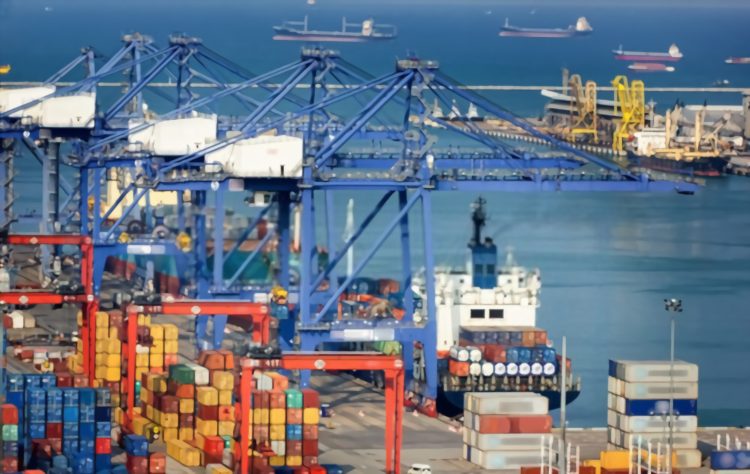Although Covid 19 became a “black situation” (a metaphor for the dire consequences of some rare and unpredictable events), the Ukraine war could be a “black hippo” (a metaphor for an economic situation in which stunted growth is accompanied by high inflation. ) To become. Meanwhile, the first crisis that may arise due to this war is the crisis of raw materials and the food supply chain disruption because The Ukraine War will probably disrupt the extensive production and export of wheat in Russia and Ukraine.
How has the Ukraine war-affected global trade?
The ongoing conflict between Russia and Ukraine will reportedly have significant ramifications for the global economy, which is just recovering from the stress of the coronavirus pandemic. The International Monetary Fund (IMF) had pointed out earlier that Russia and Ukraine are major commodity producers, and disruptions there have resulted in soaring global prices, especially that of oil and natural gas. With Ukraine and Russia accounting for up to 30% of the worldwide wheat exports, food prices have also jumped. The IMF added that the entire global economy would feel the effects of slower growth and faster inflation.
The World Bank also said in its Spring 2022 Economic Update for Europe and Central Asia that the conflict delivered a second major shock to the global economy in two years and caused a humanitarian catastrophe. “Even before the Ukraine war, the global recovery had already been decelerating alongside intensifying geopolitical tensions, continued COVID 19 flare-ups, diminishing macroeconomic support, and lingering supply bottlenecks,” it noted. As the war approaches its third month, however, the economic fallout from the conflict is becoming more apparent, and the outlook does not look good. Against an already turbulent backdrop of global inflationary pressures, the war between Russia and Ukraine exacerbates supply and demand tensions and negative consumer sentiment and threatens global economic growth.
The Ukraine war and the effects of Covid 19
During the COVID 19 crisis spanning 2020–21, the stock of international migrants declined. The Ukrainian situation has reversed that trend. Including the Ukrainian refugees, the supply of international migrants and refugees is likely to reach around 286 million in 2022. The Ukraine crisis will affect the global governance of migration in the coming years. As of the end of April 2022, according to the UNHCR, 5.5 million Ukrainians had left for Poland and other countries. An even more significant number of persons had been displaced internally. The rapid pace and scale of the displacement of Ukrainians have shifted global policy attention away from other developing regions and peoples affected by fragility, conflict, and violence. It has also shifted policy makers’ focus from addressing economic migration to addressing refugees’ needs. This shift will likely affect the proceedings and outcomes of the upcoming International Migration Review Forum.
The Ukraine crisis has further strengthened the case for creating a Concessional Financing Facility for Migration to support both destination communities experiencing a large influx of migrants and origin communities experiencing return migration during the COVID 19 crisis. As the long-term and short-term consequences of this crisis begin to unfold, it is increasingly evident that supporting host communities is the need of the hour. The war in Ukraine has also affected international payment systems, with important implications for cross-border remittance flows from Russia to Central Asian countries that significantly depend on Russia’s remittance inflows. The exclusion of Russia from the SWIFT payment system has added a national security dimension to international payment systems, which will likely become multipolar in the future. A continuation of different payment systems or even further diversification/fragmentation is expected to slow progress in fostering interoperability of payment systems and reducing remittance fees.
The poverty and hunger caused by the Ukraine War over the World
The World Bank’s baseline projection assumes Ukraine’s poverty, based on the $5.50 per day threshold rate, will increase from 1.8% in 2021 to 19.8% in 2022. It added that models developed by the United Nations suggested that a more severe and protracted war could lead to poverty affecting nearly 30% of the population.
Quoting estimates from authors of a Centre for Global Development blog, the World Bank said the latest surge in food prices could push an additional 40 million people under the $1.90-per-day poverty line. The IMF echoed similar concerns. It said in March, “Steeper price increases for food and fuel may spur a greater risk of unrest in some regions, from Sub-Saharan Africa and Latin America to the Caucasus and Central Asia, while food insecurity is likely to increase further; in parts of Africa and the Middle East.” The conflict disrupted Ukraine’s planting and harvest season and destroyed critical fields, stores, infrastructure and production, especially in eastern Ukraine. Moreover, the competition has halted shipping from the Black Sea, where about 90% of Ukraine’s grains are exported.
For the Middle East and North Africa, it had stated that rising prices might lead to social tensions, especially in countries with weaker social safety nets, fewer job opportunities, limited fiscal space and unpopular governments. This extends to Egypt, which imports about 80% of its wheat from Russia and Ukraine. Further, IMF noted that food pressures in Asia should be eased by local production and greater reliance on rice than wheat. “Costly food and energy imports will boost consumer prices, though subsidies and price caps for fuel, food and fertilizer may ease the immediate impact—with fiscal costs,” it said.
Energy is the “main spillover channel” for Europe, with Russia being a prominent provider of natural gas. The World Bank noted that the price rise for European natural gas has been particularly sharp because of their limited spare capacity, including import and export terminals, and the constraint that natural gas must be transported as liquified natural gas. According to the IMF, economies reliant on oil imports would see wider fiscal and trade deficits and more inflation pressure. However, exporters in the Middle East and Africa may benefit from higher prices. In the long term, the war may fundamentally alter the global economic and geopolitical order should there be a reconfiguration of supply chains, fragmentation of payment networks, shift in energy trade, and countries rethink reserve currency holdings, it said.
Conclusion
The war in Ukraine is causing worldwide disruptions to trade and investment, affecting automakers in Europe, hoteliers in Georgia and the Maldives, as well as impacting consumers of food and fuel globally. Although the World’s poor—who spend a large part of their incomes on life’s necessities—are the most vulnerable, no country, region, or industry is left untouched by these disruptions. A new World Bank report — The Impact of the War in Ukraine on Global Trade and Investment — shows that world trade will drop by one per cent, lowering global GDP by just under one per cent. Manufacturing exporters such as Vietnam, Thailand, and Mexico see a sharp decline, especially in energy-intensive sectors.
Net exporters of crops, including Turkey, Brazil, and India, and of fossil fuels, such as Nigeria and countries in the Middle East, see a surge in their exports, attenuating the adverse effects of the war. The economic shock waves are moving through five channels: commodity markets, logistics networks, supply chains, foreign direct investment (FDI), and sectors such as tourism. The war comes at a difficult moment for the world economy. The recovery from the pandemic-induced recession has slowed as new coronavirus variants emerged and governments reined in spending. Rising inflation has prompted the Federal Reserve and other major central banks to raise interest rates. Disruptions in world trade and investment will curb growth in developing countries and add to price pressures.





























